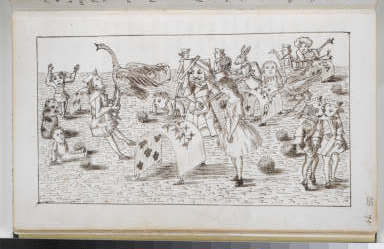© 2005 All Rights Reserved. Do not distribute or repurpose this work without written permission from the copyright holder(s).
Printed from https://www.damninteresting.com/retired/into-the-looking-glass/
This article is marked as 'retired'. The information here may be out of date, incomplete, and/or incorrect.

A few years ago, there was a commercial for some computer manufacturer or telephone company, or something of the like, showing someone in a library watching a computer screen with an open book on it. The excitement was that soon emerging technologies would allow libraries to share books over the internet, allowing one to read the book like one was there. I hadn’t seen it until now.
The other day perusing the BBC news site, I noticed a link adverstising an original “Alice” manuscript by Carroll. Being a Lewis Carroll fan, I decided to investigate. My search led me to the The British Library. In the recent past, the British Library opened a project called Turning the Pages.
Turning the Pages is the answer to prayers of lovers of books and antiquities everywhere. Not only does it allows one to read a book in its intended form, but it also allows one to turn through its pages. I was able to open the original handwritten manuscript of “Alice’s Adventures Under Ground” and behold the works of a beloved author. I could click page after page, simulate turning the pages, and zoom in on text and images.
That was not all. Other books featured on the project were manuscripts from Jane Austin, Da Vinci’s notebook, the Diamond Sutra (the first book ever printed), and others. Not only do you get the pure joy of looking at something unique and rare, but you also have the opportunity to step through the looking glass and see into the author’s soul by the work of his own hands.
© 2005 All Rights Reserved. Do not distribute or repurpose this work without written permission from the copyright holder(s).
Printed from https://www.damninteresting.com/retired/into-the-looking-glass/
Since you enjoyed our work enough to print it out, and read it clear to the end, would you consider donating a few dollars at https://www.damninteresting.com/donate ?
Why hasn’t anyone commented on this? It’s incredible!
Very true Halley (my excuse is it’s the 1st time I read it..hehe).
Other than the obvious historical/cultural interest. It’s vastly scientific as well, encompassing some ‘softer’ sciences like handwriting and calligraphy, to ‘harder’ sciences (assuming they use ‘supercameras’ to determine ink/paper composition,ect). Pictures can be worth 1,000,000 words now-a-days.
OMG! This is this bibliophiles dream come true! Thank you Josh Harding! This is beyond Damned interesting!
Thank you God, for showing me DI.
Wow, this is amazing!
I am grateful for this gift. Thank you, DI. What a treat to be able to actually look at these great works and see the handwriting of masters. I got chills looking at Mozart’s musical diary…
Enter your reply text here. OK
Good stuff. The technology does not impress me. This should be expected. Preservation is key, but now what. Are you going read that? A modern paper version is perhaps easier.